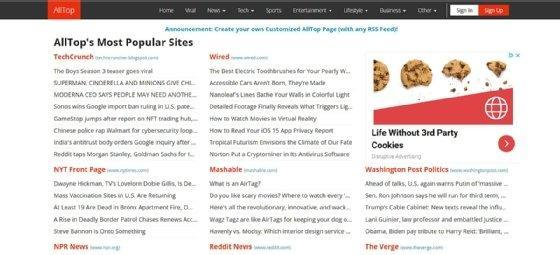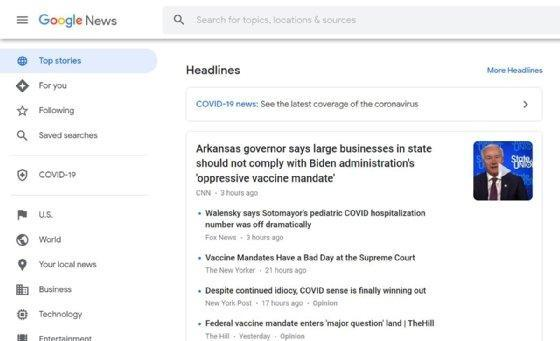Staying abreast of the latest developments in your field is a must for content creators and social media managers. Yet, it can be daunting to take in all the available information. Staying up-to-date with the latest news and trends can be daunting, but content aggregators make it easier. That’s where content aggregators come in.
This blog post will explore content aggregation and why it’s useful for individuals and businesses. We’ll examine some well-known content aggregator websites and programs that can assist you in collecting and organizing pertinent material from numerous sources.
Lastly, we will highlight some best practices for finding quality news sources within these platforms, such as Google News or Huffington Post.

What is a Content Aggregator?
Content aggregators are powerful tools for content marketers, entrepreneurs, bloggers, social media managers and website owners. They provide a comprehensive content library from multiple sources in one central location. This allows users to access relevant information on any topic or interest quickly.
Content aggregators gather information from various sources, such as websites, blogs, RSS feeds and social media accounts, to organize into categories according to topics or interests. The platform then organizes the collected data into categories based on topics or interests the user can easily access.
An example of a content aggregator could be utilized to generate an online depository of articles about marketing fads or enterprise counsel continually renewed with fresh material from various origins.
Benefits of Using Content Aggregators
Provide An Efficient Way To Find Relevant Information Quickly
Content Aggregators provide an efficient way to find relevant information quickly and easily. Content aggregators offer a practical way to obtain pertinent data promptly and conveniently, thus enabling marketers to save time by not having to search numerous sources for the same info.
Marketers can direct their attention to other marketing endeavours by utilising content aggregation, such as crafting captivating material or optimizing their websites.
Build Valuable Backlinks And Your Rank
While this is only sometimes the case, aggregating content from other publishers can help them build valuable backlinks. Having high-quality, relevant links to other sources can help you rank higher. Furthermore, those publishers may share the love and link back to you. High-quality backlinks account for up to 30% of your Google ranking score, in case you didn’t know.
Stay Up-To-Date With Industry Trends
Content aggregators also help marketers stay up-to-date with industry trends and news. They can monitor topics related to their niche, giving them a better understanding of what’s happening in their industry so they can adjust accordingly.
Content aggregators also facilitate locating influencers who may be beneficial for marketing campaigns.
Amplify Brand Recognition
When employed competently, content aggregators can augment involvement and amplify brand recognition using amplified visibility on social media sites such as Twitter, Facebook, Instagram and LinkedIn.
Marketers can use content aggregation tools like Hootsuite or Feedly to curate quality content from various sources that will appeal to their target audience and encourage them to share it with others online – increasing brand reach exponentially.
Save Time
By employing a combination of keywords within your chosen topic area, you can hone in on the type of articles you want displayed in your feed, saving time scrolling through irrelevant posts that won’t pique readers’ interest enough to get them clicking back on your site.
Utilizing a content aggregator effectively will enable you to curate quality content from various sources that will appeal to your target audience and spur them into sharing it with others online – exponentially increasing brand reach.
Free Trials
Finally, another benefit is that many companies offer free trials allowing users to test out features before committing long-term. This allows marketers to assess whether they would benefit from investing in a paid subscription before deciding.
Types of Content Aggregators
Aggregators differ in the type of content they work with and the sources from which they gather content. Aggregators collect content from multiple sources and organize it in one location for easier curation. For example, a company might use an aggregation tool to organize its internal content.
The six types of content where an aggregator may be used are as follows:
How to Use Content Aggregators Effectively?
To view the content of their choice, content consumers can use one of the tools listed above. Individuals who want content aggregation can use a site like WordPress to display aggregated content cheaply.
Running a content aggregator site is similar to running a website with specific functionality and will necessitate the following:
Subscriptions are frequently available for hosting services and domain names. The content can then be published on a website using RSS feeds that users have customized.

These are the four best practices to follow when aggregating content:
Tips for Optimizing Your Content Aggregation Strategy
Optimizing your approach is important to get the most out of your content aggregator strategy. To maximize your content aggregator strategy, consider optimizing your approach using these tips.
Set Up Alerts
Setting up alerts will notify you when new content related to your topic or interest appears online. This can save you time in manually searching for relevant information. You can set up these alerts with many popular search engines like Google and Bing and through specialized services such as Talkwalker Alerts or IFTTT (If This Then That).
Create Filters
Utilizing filters lets you narrow the results based on specific language or date range criteria. For example, if you’re looking for articles about a particular subject from within the last month written in English, setting up filters accordingly will give you more accurate results than simply doing an unfiltered search query.
Organize Your Library Of Content
A tagging system makes organising your library of content according to categories or topics easier. This allows other users who come across your curated material to quickly determine what type of article they are reading by scanning through its tags instead of having to read through all the contents before making an informed decision on whether it’s worth their time.
Additionally, keywords can be added for further optimization and clarity. With this in mind, you’ll be able to craftily curate content with people eating out of the palm of your hand.
Several optimisation tools enable users to customize their searches further so that only relevant information is returned when performing queries using certain keywords and phrases.
Examples of these tools include Buzzsumo, Quuu Promote and ContentGems, which all provide various features tailored towards helping marketers curate better quality content faster while saving money in the process too.
Challenges with Content Aggregation
Content curation can be beneficial for those in the content marketing, business, blogging, social media management and website ownership fields. Yet, employing content aggregators presents certain difficulties that must be tackled to guarantee success.
Ensuring The Reliability Of Sources
The first challenge is ensuring the reliability of sources when adding them to your library of resources. It’s important to verify the authenticity of any source before including it in your list so you don’t risk sharing inaccurate or misleading information with your readers.
Verifying the source by a credible institution, like Google News, should be considered before adding it to your library of resources.
Staying Organized
Another challenge associated with content aggregation is staying organized and keeping track of all the sources you have added to your library. With an efficient system for managing these sources, finding specific pieces of content can become easier when needed.
To help streamline this process, consider creating categories for each type of resource and tagging each piece accordingly so they can easily be found later on down the line if necessary.
Finding Ways To Make Their Posts Stand Out
Another issue many people face when using content aggregators is finding ways to make their posts stand out from similar ones being shared around the web at any given time. This means thinking outside the box and creating creative ideas to capture people’s attention while delivering valuable information related to their niche topic or brand identity.
One way to do this is to create interactive visuals like infographics or videos, which provide viewers with more engaging experiences than text alone offers them otherwise.
Best Practices for Using Content Aggregators
Stay Ahead Of The Competition
Staying ahead of the competition requires a professional with an IQ of 150 to update their content library with new, reliable sources regularly; utilize keyword optimization techniques; set up alerts; create filters; organize the library using tags and monitor industry trends.
Aggregators can acquire top-notch material for sites, blogs and social media platforms if the right techniques are employed.
Select Credible And Relevant Sources To The Topics
When selecting sources for your content aggregation strategy, make sure they are credible and relevant to the topics you cover on your site. This will help keep visitors engaged while also helping search engines understand what type of content you offer. Additionally, update your library regularly so readers can access fresh material whenever they visit.
Keyword Optimization
Keyword optimization is another essential component of successful content aggregation strategies. By incorporating popular keywords into titles and descriptions of articles and using them within the body text, you can increase visibility on search engine results pages (SERPs).
It’s also important to use specific terms related to each topic covered. This helps readers find more targeted information about their interests faster than generic terms would allow them to.
Alerts
Alerts are an excellent way for busy marketers and entrepreneurs who need more time to manually check sites daily for new updates or changes in topics covered by their chosen sources. Setting up alerts allows users to get notifications whenever new pieces become available, making staying informed much easier than scrolling through multiple websites individually, looking for updates daily.
Monitor Trends Within Industries
It is also important to monitor trends within tracked industries by keeping tabs on current events, news stories, etc., to identify potential opportunities or threats early enough to take advantage of or avoid accordingly before competitors do the same.
Following these best practices will help ensure success when leveraging the power of automated aggregation tools, making curating high-quality and engaging material a breeze compared to traditional methods used in the past.
FAQs About Content Aggregators
Conclusion
Aggregating content is an effective approach to curating and sharing material on multiple channels. When done correctly, it can help you build a following around your brand or niche by increasing visibility and engagement with potential customers. Knowing the various content aggregators, their proper utilization, creating a successful approach, and potential hurdles are all essential to maximizing the advantages of content aggregation to expand your reach and online presence.
Grow your online presence and increase engagement with content marketing strategies. Use mindflowmarketing’s comprehensive tools to build a following around your brand or niche.
